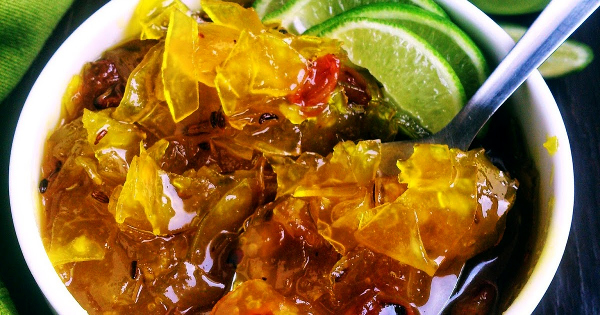Few countries hold chutneys as an accompaniment to meals in higher regard than India. But in the state of Bengal, there’s one that stands tall as a star-dessert dish in its own right, albeit with a strange name – plastic chutney.
The name of this West Bengali palate cleanser may raise a few eyebrows, but rest assured, plastic chutney contains nothing in the way of BPA-laden, kitchen-grade plastic. Glossy, translucent and perfectly safe to ingest, plastic chutney is a festive menu staple that takes its name not from its ingredient list – raw green papaya cooked in sugar syrup – but from its appearance, which resembles gooey, melted plastic in a bowl.
Refreshing and simple to make in large quantities, plastic chutney regularly appears on the menu at weddings and other festive ceremonies as a dessert year-round, in particular during the monsoon months (late June through to September) when mangoes and pineapples are out of season. It helps that in India, green papayas (in Bengali, pepe) are in abundance all throughout the year on the subcontinent, often growing on trees in backyards across the country.
What better way to use up all that extra fruit than by making a flavour-loaded sweet chutney?
While chutneys made with mango or pineapple feature more frequently in Bengali home kitchens (mango during summer, pineapple for spring), the Ayurvedic properties and ubiquity of papayas in India means bowls of glistening plastic chutney are never far away. In the Indian Ayurvedic tradition, papayas are said to aid digestion, provide a vitamin C boost and help to neutralise free radicals in the body – plastic chutney could almost pass as a healthy dessert.

The base recipe for plastic chutney calls for just three ingredients: de-seeded raw green papaya, sugar and a pinch of salt. Cashews, currants and lemon or lime juice are often added to inject a pop of colour, texture and a sour hit to offset the sweetness of the candied papaya. And the riffs don’t stop there – adding chilli and/or saffron and topping off a bowl of plastic chutney with a few cinnamon sticks isn’t totally unheard of. The key takeaway here is that plastic chutney is open to interpretation, depending on the occasion and personal preference.
In other Indian states, chutneys act as accoutrements to the main dish – full-flavoured, herb-based chutneys flesh out sandwiches in the north, and spicy coconut-based sambals add a dose of heat to dosas and idlis in the south. But in Bengal, where the cuisine leans heavily on confectionery, plastic chutney is a worthy dessert all on its own. You’ll find it on traditional Bengali wedding menus alongside other quintessential sweets like mishti doi (a curd-based dessert), roshogolla (doughnuts dipped in a sweet syrup) and malpua (a kind of miniature pancake made with flour, sugar and coconut).
What to do when life gives you an excess of papayas? Make like a Bengali, and turn them into plastic chutney.
Source: SBS
Image Courtesy: MyTrystwithfoodandtravel /Tropi Thai
You may also like
-
India Against Mpox
-
Combination of ‘Siddha’ Drugs Reduces Anemia in Adolescent Girls: Study
-
Suspected Mpox Case Under Investigation; Patient Put Under Isolation, No Cause for Alarm
-
Prime Minister Applauds India’s Best Ever Performance at the Paralympic Games
-
National Exit Test (NExT) for Ayush to be Effective from 2021-2022 Batch: Union Minister of Ayush Shri Prataprao Jadhav
